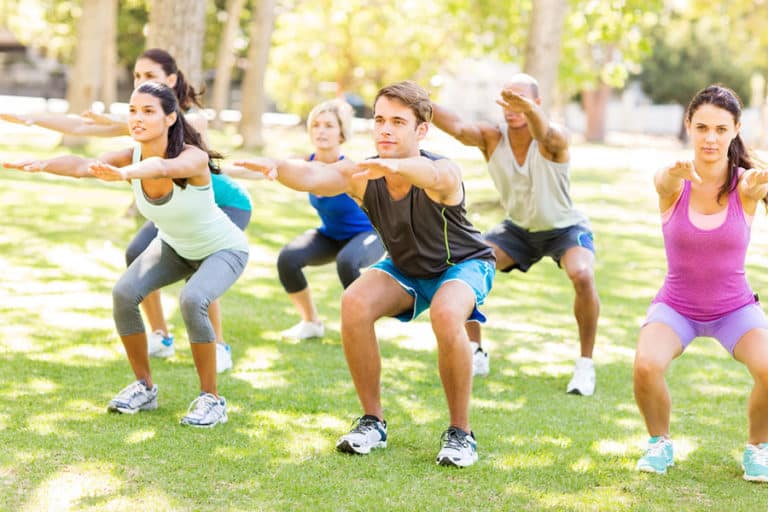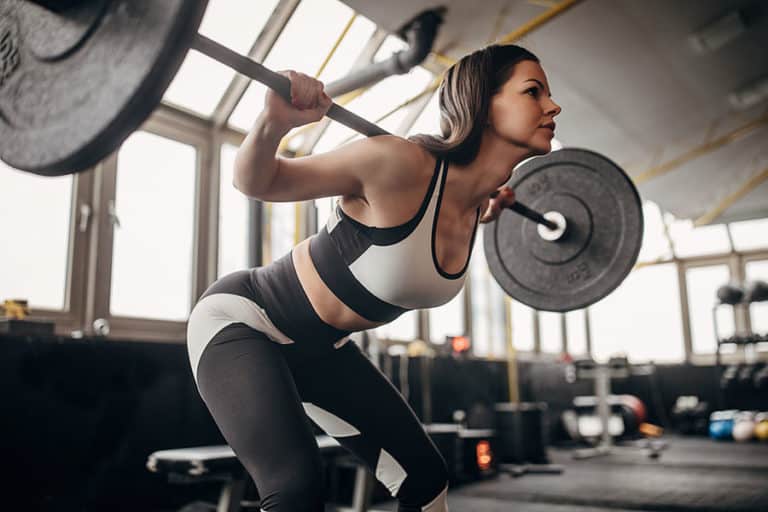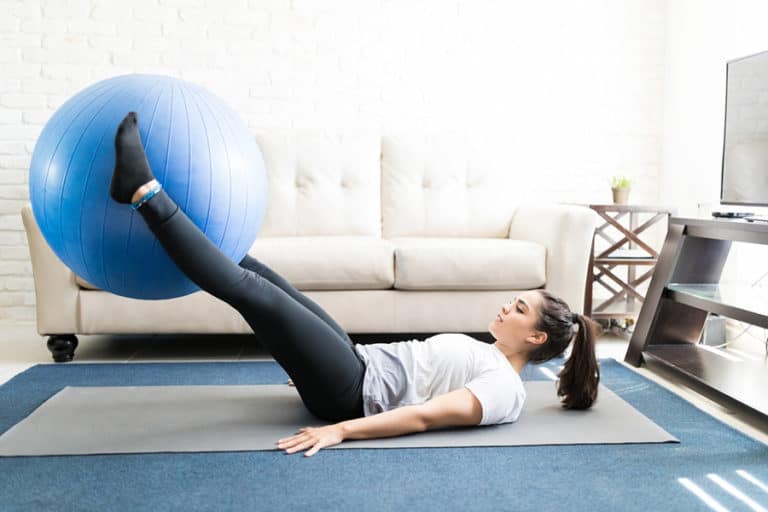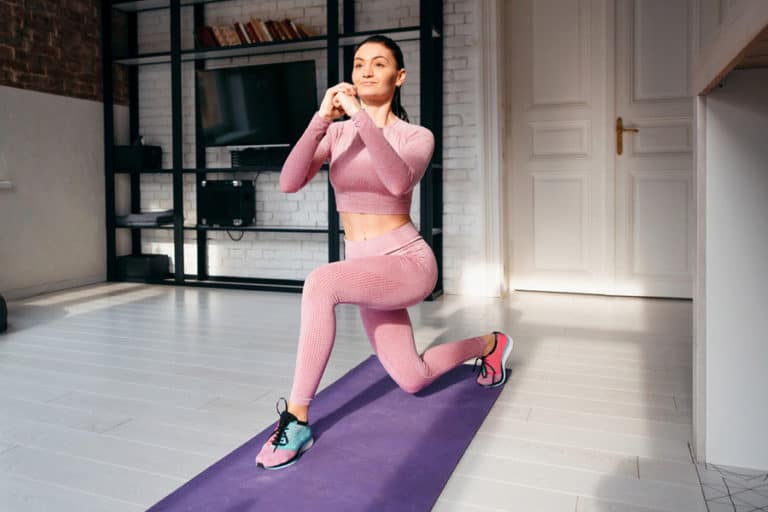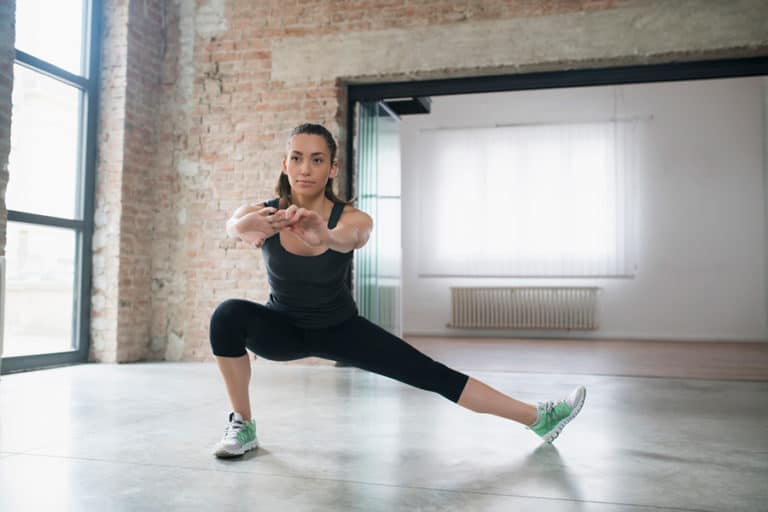21 Types Of Squats: Proper Form, Variations and Benefits

what are squats | Categories | Bodyweight Squats | Weighted Squats | Benefits | Common mistakes | tips
A dynamic exercise form that engages multiple lower-body muscles, squats are a great way to improve strength and stimulate muscle growth. They can increase balance, coordination, and agility when performed regularly.
Having the ability to execute squats with the right form and technique can take time and effort. Proper knowledge and guidance are the keys to executing perfect squats each time.
What are squats?
Squats are a type of exercise that utilizes fundamental lower-body movement patterns to strengthen multiple muscle groups simultaneously. It is performed by bending at the knees and hips, then standing back up.
This movement can be performed with or without weights, making it a versatile exercise for people of all fitness levels.
Squats are one of the most effective exercises for toning the lower body and can also help to improve balance and coordination.
What muscles do squats work?
Squats work many different muscles in the lower body. They also help strengthen the core muscles, including the abdominals and lower back.
So, if you are wondering what muscles do squats work? Here is a list of muscles that benefit from squats:
- Glutes – There are three gluteal muscles- gluteus maximus, medius, and minimus.
- Quadriceps – Quads are a group of four muscles- rectus femoris, vastus intermedius, vastus lateralis, and vastus medialis.
- Hamstrings – The hamstrings are a group of three powerful muscles on the back of your thigh- semimembranosus, semitendinosus, and biceps femoris.
- Calves – Calf muscles are a group of 2 muscles- gastrocnemius and soleus.
- Adductors – Hip adductors are a group of five muscles, including adductor brevis, adductor longus, adductor magnus, pectineus, and gracilis.
- Hip flexors – Hip flexors include the iliopsoas and rectus femoris muscles.
How many calories do squats burn?
The number of calories burned from squats depends on various factors, including the person’s weight, the intensity of the squats, and the number of squats performed.
So, how many calories do squats burn?
On average, squats can burn anywhere from 5-8 calories per minute. However, it also depends upon the MET value (Metabolic Equivalent of Task) [1]National Academy of Sports Medicine: METABOLIC EQUIVALENTS FOR WEIGHT LOSS: WHAT ARE THEY & HOW TO CALCULATE THEM.
For instance, going by MET value calculations, someone who weighs 160 pounds may burn approximately 300-310 calories by performing vigorous squat workouts for 30 minutes.
How many squats should I do a day?
There is no one-size-fits-all answer to the question, “how many squats should I do a day?” The number of squats you do in a day will depend on your fitness goals and your current fitness level.
If you are new to squats, start with 2-3 sets of 10 squats and gradually increase the number as you get stronger.
Categories of squats
Squats can be broadly classified under three categories based on their depth. Each of these categories is unique in terms of the challenge they pose to the body, the muscles they activate, and the benefits they offer.
Let us take a closer look at each of these categories.
1. Basic squat
A basic squat (also known as parallel squat) requires you to squat to a parallel. This means your thighs are parallel to the floor at the bottom of the squat. A basic squat can be performed without any weights. It targets the quads, glutes, and hamstrings.
How to do:
- To do a basic squat, stand with your feet shoulder-width apart and your toes pointing forward.
- Now lower your hips and bend your knees to lower your body into a squatting position.
- Make sure your knees are in line with your toes and your thighs are parallel to the floor.
- Hold this position for a few seconds, and then raise your body back to the starting position.
2. Half Squat
Half squats are also referred to as partial squats. This category of squats is performed without the hips hitting parallel. In other words, you stop squatting a little before your thighs are parallel to the floor. This is a convenient squat category for those who cannot bend their hips or knees deeper.
How to do:
- To do a half squat, stand with your feet shoulder-width apart and your toes pointing forward.
- Now lower your hips and bend your knees to lower your body into a squatting position.
- Make sure your knees are in line with your toes.
- Stop before your thighs are parallel to the floor and hold this position for a few seconds.
- Drive through your heels to raise your body back to the starting position.
3. Deep Squat
Deep squats are also referred to as full squats. This category of squats requires your hips to descend below the level of your knees. The angle of your knee joint will be less than 90 degrees at the lowest point.
How to do:
- Start with your feet slightly wider than shoulder-width apart, toes pointing out at a 45-degree angle
- Keeping your head up and back straight, lower your hips and glutes back and down until your legs have lowered past parallel to the ground and your knees are at less than a 90-degree angle.
- Hold this stance for a moment and then press back up to the starting position.
11 Types of bodyweight squats
Bodyweight squats are squat variations done without added weights. They are a great way to work out your body without going to the gym. A bodyweight squat can help to improve the strength and stability of the lower body muscles.
Here are 11 types of bodyweight squats you can try:
1. Wall squat
A wall squat helps to improve the quads, glutes, and hamstrings. They are good for beginners as they provide support to the back [2]Arthritis Foundation: How to Squat Correctly. You may choose this squat variation if you are prone to knee pain.
How to do:
- Stand with your back against a wall and your feet shoulder-width apart.
- Take two steps away from the wall.
- Now lower your hips and bend your knees to slide down the wall until your thighs are parallel to the floor.
- Make sure your knees are in line with your ankles.
- Hold this position for a few seconds, and then raise your body back to the starting position.
2. Air Squat
An air squat is a basic squat that can be done without any equipment. It requires you to squat deep and raise your arms simultaneously. This squat variation is fantastic for increasing strength and endurance.
How to do:
- To start, keep your feet shoulder-width apart and toes pointed slightly outward.
- Extend your arms out in front of you and lower your hips and glutes back and down into a squat.
- Squat until your position looks like you are sitting in a chair.
- Be sure to keep your head up and back straight throughout the movement.
- Once you have reached the bottom of the squat, press through your heels to return to the starting position.
3. Sumo squat
The sumo squat employs a wide stance making it a great exercise to light up your adductors (inner thigh muscles) and glutes. Its range of motion targets the inner thigh muscles that are generally neglected in other squat formats.
These squats are great for those who want to sculpt their leg muscles and improve their balance.
How to do:
- Start by placing your feet wider than shoulder-width apart, with your toes pointing out at a 45-degree angle.
- Clasp your hands together at chest level and engage your core and glutes.
- Keep your back straight, slowly bend your knees and lower your hips like you are sitting in an (imaginary) chair.
- Keep going down until your hips are lower than the level of your hips.
- After pausing for a moment, press through your heels to return to the standing position.
4. Bulgarian split squat
The bulgarian split squat is also known as the rear foot elevated split squat. It is a single-leg exercise that targets the quads, glutes, and hamstrings. This move also helps to improve balance and stability.
How to do:
- To start, stand in an upright position with one foot placed behind you on a bench or chair.
- Slowly lower your hips and glutes straight down towards the floor.
- Once your rear knee nearly touches the ground, press back up to the starting position.
- Repeat the movement for the desired number of reps, and then switch legs.
5. Pulse squat
The pulse squat movement works all the muscles used in standard squats, with added tension for an extra burn. Small but effective pulses quickly fatigue your muscles, making this move a great way to end a leg workout.
How to do:
- Start by standing with your feet shoulder-width apart and your toes pointed slightly outward.
- Clasp your arms out in front of you and lower your hips and glutes back and down into a squat.
- Squat until your thighs are parallel to the ground or slightly below.
- Once you reach the squat position, start to pulse your hip up and down by 1 to 2 inches.
- Be sure to keep your head up and back straight throughout the movement.
- Once you have completed the desired reps, return to your standing position.
6. Curtsy lunge
A curtsy lunge combines the movement patterns of a reverse lunge and a squat. In this variation, you squat with one leg bent to a parallel while the other leg goes behind and across the front leg.
The range of motion of a curtsy squat requires a considerable engagement of the core muscle. Consequently, it improves overall balance and coordination in the body.
How to do:
- Stand with your feet shoulder-width apart, and your toes pointed forward.
- Start by placing your weight on your right foot. Then, bring your left leg across and behind your right.
- Gradually lower yourself by bending both knees until your right thigh is parallel to the floor and your left knee is close to touching the ground.
- To perform this move correctly, bend at the waistline and allow your arms to hang by your sides or raise them up to chest level for stability.
- Push yourself up through your right heel and return to the standing position.
- Repeat the movement on the other side.
7. Cossack squat
The cossack squat is a lateral variant of squats that works the muscles of the inner and outer thighs, along with the glutes. It is an excellent exercise for those who want to improve their squats or are looking for a new challenge.
How to do:
- To start, stand with your feet wider than shoulder-width apart and keep your toes pointing slightly outwards.
- Keep your torso upright and engage your core muscles to maintain good posture.
- Place your hands in front of you with your fingers interlaced.
- Firmly plant your heels on the floor and shift your weight onto your right leg.
- In a steady and controlled motion, squat on the right side. Try to squat deeper than a regular squat.
- Extend your left leg and rotate your left foot outward, placing your heel on the ground and your toes pointing towards the ceiling.
- Hold the position for a moment, and then return to the starting position.
- Repeat the movement on the other side.
8. Jump squat
Jump squats are a plyometric exercise that helps improve explosive power and strength in the legs. The movement here is similar to the regular squats, except that you jump at the end of the squat movement.
Squat jumps are a great way to add intensity to your workout and are often used in HIIT (High-Intensity Interval Training) workouts.
How to do:
- Start by standing with your feet shoulder-width apart and your toes pointing forward.
- Lower your hips back and down into a half-squat position.
- Once you reach the bottom of the squat, quickly explode up into a jump.
- As you jump, swing your arms up for momentum.
- When you land, be sure to land softly with your knees bent to absorb the impact.
- After landing, immediately lower your body back into the squat position and repeat the jump.
9. Lateral squat
As the name suggests, the lateral squat incorporates a sideward (lateral) movement. This squat is perfect for people who want to work on their balance, flexibility, and agility.
How to do:
- Start by positioning your feet shoulder-width apart with your legs forming a triangle over the ground. Keep your toes pointing slightly outwards.
- Bring your hands forward to chest level for stability.
- Lower your hips and shift your weight to your right leg.
- Bend your right knee so that the thigh is parallel to the floor.
- Fully extend your left leg towards the side, making sure to keep your foot flat on the ground.
- Hold the position for a moment, and then return to the starting position.
- Repeat the movement on the other side.
10. Single-leg squat
A single-leg squat is a beginner-friendly, unilateral squat form. In this variation, you perform a partial or a parallel squat with one leg extended in front of you.
Unlike pistol squats, you do not lower your hip beyond your knees for a single-leg squat. Therefore, this squat has less impact on the knees and is a good choice for people with knee pain. It also helps to improve balance and stability.
How to do:
- Start by standing on your left leg with your right leg extended in front of you.
- Keeping your shoulders square, lower yourself down into a squat by bending your left knee.
- Once your left thigh is parallel (optional) to the ground, stop and hold the position for a moment.
- Then, slowly return to the starting position.
- Repeat the movement on the other side.
11. Pistol squat
The pistol squat is an advanced variation of the single-legged squat. This challenging move requires both strength and balance. However, it is a great way to develop flexible ankle joints.
How to do:
- Start by standing on your left leg with your right leg extended in front of you.
- Keeping your shoulders square, lower yourself down into a squat by bending your left knee.
- Once your left hip is lower than your left knee, stop and hold the position for a moment.
- Then, slowly return to the starting position.
Squat variations with weights and equipment
Although the effectiveness of the basic squat can not be denied, there are plenty of weighted variations that you can add to your squat routine.
Here are 10 weighted squat variations:
1. Dumbbell squat
You can try the dumbbell squats if you’re looking for a versatile lower-body exercise to add to your strength training program. It is a compound exercise that involves holding a pair of dumbbells at your sides while lowering yourself to a squatting position. The dumbbells add resistance that helps build muscle.
How to do:
- Stand with your feet shoulder-width apart and hold a dumbbell in each hand, keeping your hands at your sides.
- Keeping your back straight, lower your body as far down as you can by pushing your hips back and bending your knees.
- Pause for a moment, then slowly raise yourself back up to the starting position.
2. Goblet squat
A goblet squat is when you perform a traditional squat with a weight in front of the chest. It is a versatile squatting exercise in which you can use a kettlebell, dumbbell, or medicine ball.
Goblet squats target the core and leg muscles, and the extra weight improves strength.
How to do:
- Start by holding a kettlebell close to your chest with both hands.
- Stand with your feet shoulder-width apart.
- Make sure to keep your elbows close to your body, abs engaged, and back straight.
- Start to lower your body by moving your hips down.
- Continue to lower your body until your hips are below your knees, and hold the squat position for a moment.
- Push yourself up by driving through your heels until your hips and knees are back in the starting position
3. Landmine squat
The landmine squat is a front-loaded squat variation. You perform this squat by lifting the free end of an angled barbell attached to a landmine machine.
This squat places less stress on the lower back than other variations of barbell squats. However, the landmine squats are great for targeting the quads.
How to do:
- Position the barbell in a landmine base and load it with weight.
- Stand with your feet shoulder-width apart.
- Grip the end of the barbell with both hands and raise it to your chest.
- Keeping your back straight, lower your body down into a squatting position.
- Pause for a moment, and then press through your heels to raise yourself back up to the starting position.
4. Box squat
The box squat is a multi-muscle exercise that uses a barbell and plyometric box to target muscle groups all over the body. It is an excellent choice if you are new to weighted squats.
This exercise helps to slow your movement and allows you to refine and control the entire range of motion.
How to do:
- Start by placing a plyometric box behind you and setting a barbell on a squat rack at about shoulder height.
- After loading the barbell with weight, step back and position your feet shoulder-width apart.
- Grip the barbell with an overhand grip and place it on your back.
- Step backward until your shins touch the box, and then lower your body down into a squatting position.
- Pause for a moment, and then press through your heels to raise yourself back up to the starting position.
5. Smith machine squat
Smith machine squats are great for beginners who want to start performing weighted squats. It is performed with a weight machine that has a barbell attached to it that moves in a fixed path.
How to do:
- Start by setting the barbell on the Smith machine at about shoulder height.
- Place your feet shoulder-width apart and grip the barbell with an overhand grip.
- Keeping your back straight, lower your body down into a squatting position.
- Pause for a moment, and then press through your heels to raise yourself back up to the starting position.
6. Hack squat
Hack squats are performed using a hack squat machine. It is excellent for people who want to improve their leg strength and their squat form. The machine makes it easier to perform deep squats with weights.
How to do:
- Adjust the hack squat machine to your height and position yourself in it.
- Grip the handles of the shoulder pads and place your feet shoulder-width apart on the foot plate.
- Keeping your back straight, lower your body down into a squatting position.
- Pause for a moment, and then press through your heels to raise yourself back up to the starting position.
7. Front squat
The front squat places significantly less compressive stress on your knees and lower back than the back squat. This makes it a good weighted squat variation for individuals with knee or back problems.
How to do:
- Start by setting the barbell on a squat rack
- Load the barbell with weight and then step forward.
- Place your feet shoulder-width apart and grasp the barbell with both hands and hold it in front of you.
- Keeping your back straight, lower your body down into a squatting position.
- Pause at the bottom of the squat.
- From there, press through your heels to raise your body back up to the starting position.
8. Back squat
The back squat is a popular strength and muscle-building exercise. It incorporates a barbell placed across the shoulders and the traps as you perform squats.
Back squatting promotes muscle building in your glutes, quads, and hamstrings. It is also a great choice to improve your posture since you have to keep your torso steady as you lift the barbell.
How to do:
- Start by setting the barbell on a squat rack at about shoulder height and load it with the desired weight.
- Keeping your feet shoulder-width apart, stand under the bar.
- Position the barbell on your upper back and hold it with both hands.
- Lift the barbell off the squat rack and take a step backward.
- Keeping your back straight and knees slightly bent, lower your body down into a squatting position.
- Slowly drive upwards through your heels.
9. Kang squat
Kang squats are an excellent way to improve your hip mobility and flexibility while developing strength. This squat is performed by combining the movement of a back squat and the good morning exercise.
Kang squats are a great way to improve your squats and your form. It helps in toning the glutes, quads, and hamstrings.
How to do:
- Start by positioning the barbell on your upper back as you would for a back squat.
- Unrack the barbell and take a step backward.
- Hinge your hips and lean your torso forward.
- Keeping your back straight, lower your body down into a squatting position.
- Once you have reached the lowest point of the squat, hinge back up to the good morning position.
- Straighten your back and rise back up to the back squat position.
10. Overhead squat
The overhead squat is one of the most challenging among weighted squats. It is a fantastic way to build your shoulders and core strength. It’s also an excellent method to mobilize your thoracic spine, ankles, and hip.
How to do:
- Start by setting the barbell on a squat rack at about shoulder height and load it with weight.
- Keep your feet shoulder-width apart and grasp the barbell with your hands slightly wider than shoulder-width apart.
- Step backward and push the barbell overhead.
- With the barbell overhead, lower your body down into a squatting position.
- Pause at the bottom of the squat for a moment.
- Steadily press through your heels to raise your body back up to the starting position.
Benefits of squats
The list of benefits of squats is long, but to summarize and highlight the top picks, here are the significant benefits of performing squats:
- Gain lower body strength: Strength training exercises like squats are an excellent way to gain lower body strength.
- Build muscle: When you squat correctly, your body creates an anabolic environment that encourages muscle building.
- Burn fat: Squats can help you burn fat and calories, as they are a compound exercise that uses multiple muscle groups.
- Explosive power: Squats target the fast-twitch muscle fibers responsible for explosive power. When these fibers are trained and activated, they can help you become faster and more powerful.
- Stronger core: Squats engage the rectus abdominis, transverse abdominis, and obliques — all these constitute our core muscles.
- Bone and joint health: Squats can help to develop and maintain strong bones and joints. This is because they stress these areas, which stimulates the production of new cells.
- Flexibility and balance: Squats can help to improve your flexibility, as they require you to move through an extensive range of motion. They also help improve balance by increasing your proprioception — your sense of movement and positioning in space.
- Convenient: Squats can be done anywhere without equipment, making them a most convenient exercise.
- Prevent Injury: According to the American Council on Exercise [3]American Council on Exercise: 5 Ways to Supercharge the Squat, Squats are a great way to deal with injuries related to weakness and balance. This is because squats help to improve flexibility and strengthen the joints and muscles responsible for balance and coordination.
Common mistakes while doing squat workouts
Squats performance tends to vary significantly from person to person based on body size, shape, and structure. However, there are some basics that need to be kept in mind while performing squats.
Listed below are some common squat mistakes that you should know and avoid.
- Not squatting enough: One of the most common mistakes is not squatting deep enough. Most squats require you to descend until your hips are lower than your knees. This will ensure that you are working your muscles to the fullest.
- Using your arms for momentum: Another common mistake is using your arms for momentum. This will take the focus away from your legs and make the exercise less effective. Remember to keep your arms close to your body and focus on using your legs to drive the movement.
- Not keeping your chest up: It is important to keep your chest up while squatting. This will help you maintain good form and protect your back.
- Bouncing out of the bottom: Bouncing out of the bottom of a squat is a common mistake. This can lead to injury and should be avoided at all costs. Remember to control the movement and use your muscles to push through the entire range of motion.
- Not maintaining a neutral spine: Another common mistake is not maintaining a neutral spine. This can lead to lower back pain and should be avoided.
Safety tips
Despite the ease and benefits of squats, there are significant risks involved with squats when done incorrectly. A flawed squat technique may lead to injuries to the knees and spine. So are some tips for you to squat safely.
1. Incorporate some stretching and warm-up exercise
Warming up and stretching is necessary before any squat workout. It helps to reduce the risk of injury and improve the range of motion in your joints.
2. Maintain a safe grip
Maintaining a safe grip is essential while doing squats with weights. A good grip will help keep the barbell in place and maintain balance.
3. Safe stance
Having a safe stance [4]National Library of Medicine: How to squat? Effects of various stance widths, foot placement angles and level of experience on knee, hip and trunk motion and loading and position is crucial while squatting. Make sure your feet are shoulder-width apart and your knees are in line with your toes.
4. Safe handling of weights
While squats are a great way to build strength and muscle, it is essential to handle the weights safely. You may use appropriate weightlifting belts and gloves to avoid injuries.
5. Keep your back straight
Maintaining a straight back is essential while doing squats. It helps to prevent injuries and keeps the upper body intact.
6. Knees in line with toes
To avoid knee pain during squats, make sure that your knees are in line with your toes and not going over them. Also, if you have knee pain, stop the squats immediately and consult a doctor.
7. Arms
Your arms should be in line with your shoulders while squatting. Do not let your elbows flare out while doing squats.
8. Head, neck, and shoulders
While doing squats, keep your head up and look straight ahead. Do not let your shoulders round forward. Avoid jerking your neck while squatting.
9. Use proper shoes
The wrong pair of shoes can ruin your squats. Wearing the right shoes will improve your performance and reduce the risk of injury.
10. Use a squat rack for extra safety
A squat rack is a great way to add safety to your loaded squats. It helps you to control the barbell and prevents it from falling on you.
Conclusion
Performing them regularly will translate into increased lower-body strength, better muscle tone, and improved overall fitness. Trying different variations of squats can help you get the most out of your squats.
Choosing the right kind of squats and executing them to perfection will ensure that you get the desired results without any injuries.
Perfect your form and enhance your performance with the information and guidance given above to get a strong, toned, and agile lower body.
References
| ↑1 | National Academy of Sports Medicine: METABOLIC EQUIVALENTS FOR WEIGHT LOSS: WHAT ARE THEY & HOW TO CALCULATE THEM |
|---|---|
| ↑2 | Arthritis Foundation: How to Squat Correctly |
| ↑3 | American Council on Exercise: 5 Ways to Supercharge the Squat |
| ↑4 | National Library of Medicine: How to squat? Effects of various stance widths, foot placement angles and level of experience on knee, hip and trunk motion and loading |


